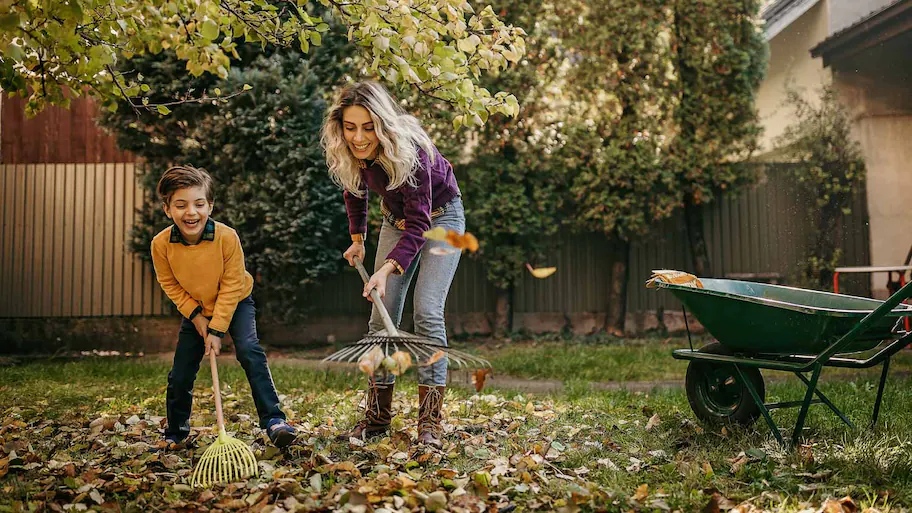As the vibrant days of summer begin to fade and the crisp air of fall starts to creep in, it’s time to start thinking about how to prepare your yard for the upcoming season. Fall is a beautiful time of year, and with a little preparation, your yard can look just as stunning as the leaves changing colors. Plus, a bit of work now will make your spring yard care a breeze! So grab your gardening gloves and let’s dive into the ultimate guide to getting your yard ready for fall.
Clean Up the Leaves
One of the most iconic signs of fall is the colorful carpet of leaves that covers your lawn. While it’s tempting to let nature take its course, letting leaves accumulate can suffocate your grass and create a haven for pests. Instead of dreading leaf cleanup, turn it into a fun family activity. Grab some rakes, jump in the piles, and then bag them up or add them to your compost pile.
If you’re not a fan of raking, consider using a mulching mower. Mulching your leaves into tiny pieces allows them to decompose naturally, adding valuable nutrients back into the soil. Just be sure not to leave thick layers of mulch, as this can smother your grass.
Trim and Prune
Fall is the perfect time to give your trees, shrubs, and perennials a good trim. Pruning helps remove dead or diseased branches, encourages healthy growth, and can even improve the overall shape of your plants. For flowering shrubs like hydrangeas and roses, prune them after they’ve finished blooming to promote a healthier plant next spring.
When trimming trees, focus on removing any branches that are damaged or growing too close to your house. This not only helps the tree but also prevents potential damage from winter storms. And don’t forget to clean up any fallen branches or twigs to keep your yard looking tidy.
Aerate Your Lawn
If your lawn has seen a lot of foot traffic over the summer, the soil might be compacted, making it difficult for water, air, and nutrients to reach the grass roots. Aerating your lawn in the fall helps alleviate compaction, promotes healthier roots, and prepares your grass for the winter.
You can rent an aerator from your local garden center or hire a professional to do the job. Aerating involves removing small plugs of soil from your lawn, which allows the soil to breathe and absorb moisture more effectively. After aerating, consider overseeding your lawn with cool-season grass to fill in any bare spots and ensure a lush lawn in the spring.
Fertilize for Fall
Fertilizing your lawn in the fall is like giving it a hearty meal before winter hibernation. A good fall fertilizer provides essential nutrients that strengthen grass roots and prepare your lawn for the colder months. Look for a fertilizer with a higher potassium content, as potassium helps improve your lawn’s cold tolerance.
Apply the fertilizer after aerating and overseeding for best results. Water your lawn thoroughly after fertilizing to help the nutrients soak into the soil. A well-fertilized lawn in the fall will green up faster and be more resilient when spring arrives.
Plant Fall Bulbs and Flowers
Fall is the ideal time to plant spring-blooming bulbs like tulips, daffodils, and crocuses. Planting bulbs in the fall gives them time to establish roots before winter, ensuring a burst of color as soon as the weather warms up. Choose a sunny spot in your garden, dig holes about three times as deep as the bulb’s height, and plant them pointy-side up. Cover them with soil, water well, and then wait for the magic to happen in the spring.
If you’re looking for instant fall color, consider planting hardy mums, pansies, or ornamental kale. These plants thrive in cooler weather and can add a pop of color to your garden beds or containers right through the fall season.
Prepare Your Garden Beds
As you prepare your garden for winter, take the time to clean up your garden beds. Remove any spent annuals, cut back perennials, and pull out any weeds that have popped up. Adding a layer of mulch to your garden beds will help protect the roots of your plants from frost and keep the soil temperature consistent.
Fall is also a great time to enrich your garden soil with compost. Spread a layer of compost over your garden beds and gently work it into the soil. This not only adds nutrients but also improves soil structure, making it easier for plants to thrive next year.
Winterize Your Water Features
If you have a pond, fountain, or other water feature, it’s important to prepare it for the colder months. Start by removing any debris like leaves or twigs from the water. If you have fish, make sure to feed them a special fall diet to help them store energy for the winter.
For ponds, consider installing a pond heater or de-icer to keep a small area of the water from freezing completely. This allows harmful gases to escape and keeps your fish safe. If your water feature has a pump, either remove it and store it indoors or follow the manufacturer’s instructions for winterizing it in place.
Wrap Up Your Yard Work
As you wrap up your fall yard work, don’t forget to take care of your tools and equipment. Clean and sharpen your pruning tools, rake, and mower blades to keep them in good condition. Drain and store your garden hoses, and consider covering your outdoor faucets to prevent freezing.
Finally, take a moment to enjoy your hard work. Fall is a beautiful time of year, and with your yard prepared for the season, you can relax and enjoy the crisp air, colorful leaves, and cozy evenings by the fire pit. When spring rolls around, you’ll be grateful for the effort you put in now.
Final Thoughts: Get Ready for a Gorgeous Fall Yard
Preparing your yard for the fall season doesn’t have to be a daunting task. With these tips, you can easily tackle each step and ensure your yard stays beautiful and healthy throughout the colder months. Whether you’re planting bulbs for a stunning spring display, aerating your lawn, or just enjoying a day of leaf raking, fall yard prep is the perfect way to connect with nature and keep your outdoor space looking its best. Happy gardening!









